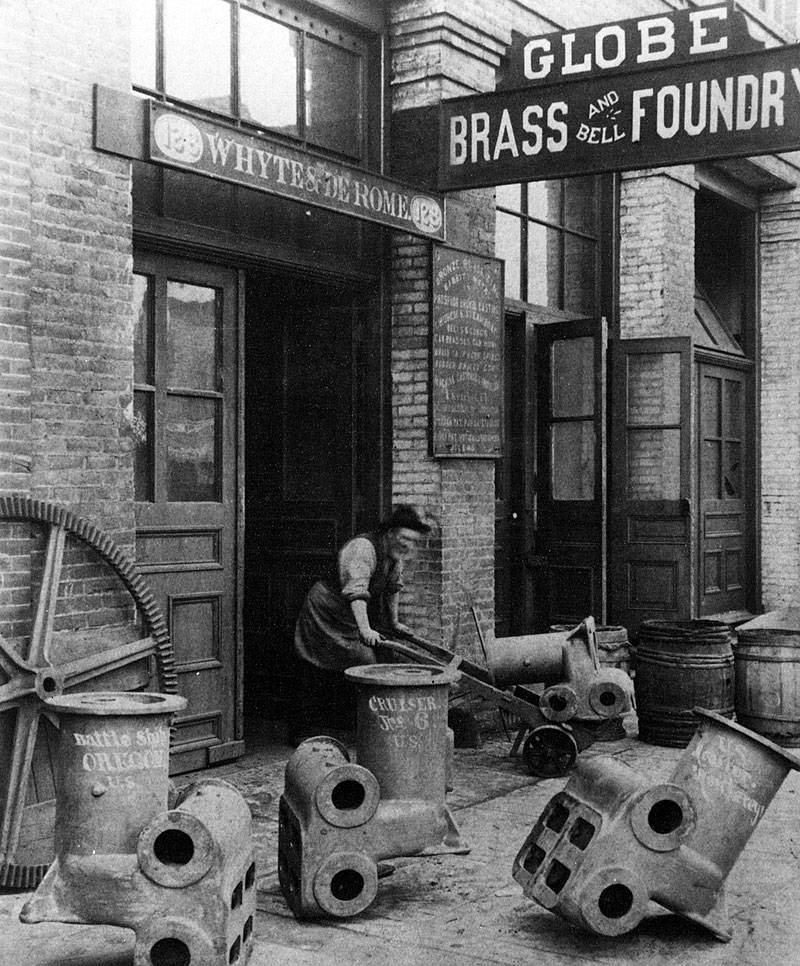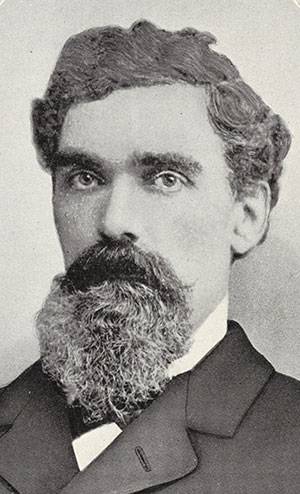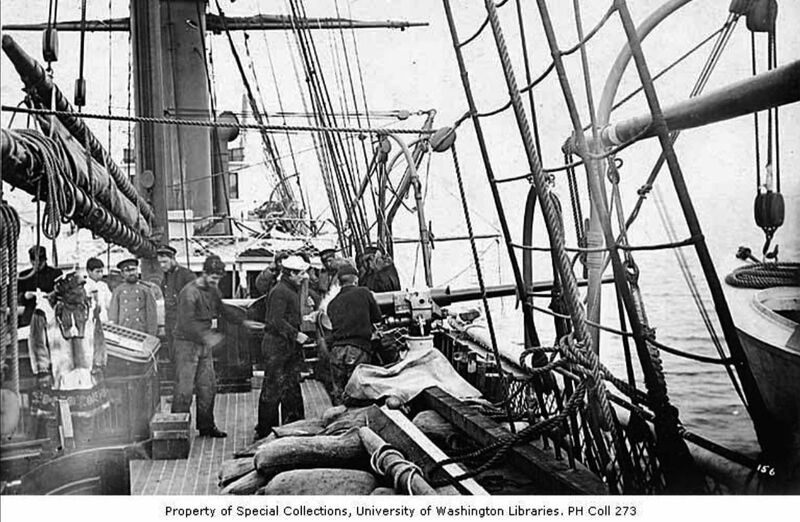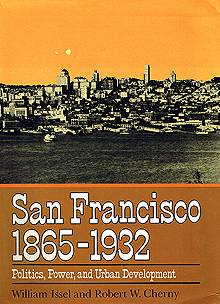Unions and Employers 1880s-1890s
Historical Essay
by William Issel and Robert Cherny
Small foundry at 128 Main Street turning out parts for warships at the Union Iron Works, c. 1890s.
Photo: Bancroft Library
We have no labor troubles. . . . We give the men what they want.
- —S. H. KENT, president of the San Francisco Building Exchange, 1905
Lucile Eaves, an early sociologist, wrote in 1910 that there was “evidence of such early trade-union activity in San Francisco that one is tempted to believe that the craftsmen met each other on the way to California and agreed to unite.” In the winter of 1849, San Francisco carpenters asked for a wage increase and struck when employers refused. Printers organized the first trade union a few months later, teamsters organized soon after, and both sailors and musicians went on strike before the year 1850 was out. These early organizations, like their counterparts in the cities of the East, lasted but a month, a year, sometimes a few years, with only a few surviving much longer. Local unions appeared, fell apart, then reappeared later in a different form. Activists created citywide central bodies, but they usually soon disappeared, to be replaced by some new group. After the 1880s, however, an increasing number of organizations survived the crises—depression, lost strikes, employer opposition—that had spelled death for earlier efforts.(1) The history of San Francisco’s labor relations falls into three time periods: from the revival of unions in the 1880s up to 1901, from 1901 to 1919, and from 1919 to the mid-1930s.
Union Activity in the 1880s and 1890s
The first of these periods saw the emergence of many of the institutions and institutional patterns that would dominate later time periods, as earlier varieties of labor organization slowly evolved into different forms. The 1880s and early 1890s brought San Francisco and the rest of the nation both economic growth and a degree of prosperity. Throughout much of the 1880s, wheat and wool poured from the interior through San Francisco outward to the world. The city’s population grew by more than a quarter, the number of manufacturing establishments increased by a third, capital invested in manufacturing more than doubled, and the number of workers employed went from 28,442 to 48,446. The expansionary economy of the 1880s and the first few years of the 1890s allowed employers to grant wage increases, and the average annual earnings of San Franciscans employed in manufacturing rose from $525 in 1880 to $639 in 1890, despite the generally deflationary tendency of the times.(2)
During the early 1880s unions revived, reorganized, or formed in many trades. The city’s expanding economy provided an ideal setting for some of these unions to post early successes; employers, reluctant to lose any of their share of this growth, gave in to union efforts, thereby repeating the pattern of the 1850s and late 1860s when unions had formed and made gains during periods of prosperity and economic expansion. Very few unions had established national affiliations before the 1880s, but during that decade many San Francisco unions did so, giving themselves a more direct link to information about other cities and a source of assistance in times of crisis.(3)
Frank Roney, Irish republican and trade union leader
Photo: History of Ireland
Anti-Chinese agitation constituted a staple of city politics in the 1870s, and the revival of unions in the 1880s brought with it a transfer of anti-Chinese agitation to labor groups. White boot- and shoe-makers, cigarmakers, and clothing workers had long viewed Chinese labor as a threat to their wages and working conditions. They had tried to protect themselves by urging consumers to boycott Chinese-made goods and to buy only products with white-labor labels. Anti-Chinese boycotts made up much of the activities of the Trades Assembly, a central body formed in 1878. Generally inactive during its first three years, the Trades Assembly jolted into action when Frank Roney became its president in 1881. The assembly added new affiliates, opposed Chinese labor and the leasing of convict labor, questioned candidates for office, and lobbied for labor legislation in Sacramento. One success came in 1883 with the creation of a state Bureau of Labor Statistics.(4) By that time, however, the Trades Assembly had ceased to meet. Two new groups, the Knights of Labor and the International Workingman’s Association, siphoned off energies of labor activists from the Trades Assembly, and Frank Roney—centrally important in many of the assembly’s activities—shifted his attention to other arenas.
Knights of Labor District Assembly 53 for San Francisco and the Bay Area organized in 1882. A year later it counted fifteen local assemblies, including eight trade assemblies. Some unions previously in the Trades Assembly apparently joined the Knights of Labor as trade assemblies. These unionists made up at least half, and perhaps as much as two-thirds, of the total membership. District Assembly 53 became inactive in the late 1880s, although some of the trade assemblies continued to function, and some eventually affiliated with the Federated Trades Council and with national unions.(5)
Crew aboardship in the far northern Pacific, apx. 1899.
Photo: University of Washington Libraries, Special Collections, WAR0519
Formed in 1882, the International Workingman’s Association (IWA) took the name of Marx’s First International to proclaim its socialist principles The moving force of the IWA, Burnette G. Haskell, impressed historian Ira Cross as “erratic and brilliant.” Educated as a lawyer, Haskell preferred the life of a publisher and radical organizer. His newspaper, Truth appeared from 1882 to 1884. and it tended, like Haskell himself, to be dramatic, extravagant, even fantastic. Haskell and some IWA activists left the city to form a cooperative colony in 1886, and the IWA soon disappeared. During its brief existence, it provided an important meeting ground for the city’s radicals, and IWA members influenced the course of the San Francisco labor movement for the next decade or more. They helped organize the Coast Seamen’s Union, the brewery workers, and the Federated Trades Council in 1886.(6)
Growth of Organization, 1886–1893
The Federated Trades Council was an ambitious attempt to create a central body for the entire Pacific Coast. Some unions and councils outside San Francisco affiliated with the new council, but delegates who came regularly all had their bases in San Francisco. Roney became the first president, and the first officers included a number of IWA activists. In the beginning, the council concentrated on opposition to the Chinese in a fashion reminiscent of the defunct Trades Assembly. In the prosperous 1880s, however, ability to win improvements in wages and hours soon supplanted the race consciousness of the late 1870s. Anti-Chinese efforts gave way to more direct organizing activities, promotion of the union label (not the white-labor label), and boycotts of nonunion products. The Council maintained a lobby in Sacramento that opposed convict leasing or convict-made goods and fought for legal protection of union labels, the secret ballot, and various inspection and licensing acts. Roney served three terms as president of the body, and, according to Cross, Roney and the council “brought renewed life to the labor movement in California.” The council affiliated with the new American Federation of Labor (AFL) and tried to persuade its affiliates to do likewise. Alfred Fuhrman, a key figure in the organization of brewery workers, served as council president in the late 1880s and early 1890s. Under his leadership, the brewery workers disaffiliated from their national union; the AFL, in turn, suspended the Federated Trades Council for refusing to expel the now-independent brewery workers’ union.(7)
During Fuhrman’s presidency, the council supported a large number of boycotts and strikes—more, apparently, than it had the capacity to handle effectively. Fuhrman’s sometimes high-handed tactics as president caused additional dissatisfaction with the council. In 1891 a number of construction unions withdrew from the Federated Trades Council to affiliate solely with a new body, the Building Trades Council. Other unions withdrew from the council because they disliked Fuhrman’s leadership, or the suspension by the AFL, or the council’s many unsuccessful boycotts and strikes. The council clung tenaciously to life (Walter Macarthur of the Sailors’ Union of the Pacific later said it “couldn’t grow and wouldn’t die”) until a conference of union representatives created a new central body, the San Francisco Trades and Labor Council, shortened in 1893 to the San Francisco Labor Council.(8)
Open-Shop Efforts and Depression in the Mid-1890s
Much of the advance of union activity in the 1880s came to a halt in 1892 and 1893 when employers launched a citywide open-shop drive and the nation plunged into a serious depression. The Board of Manufacturers and Employers of California, formed in late 1891, announced their intent “to promote the manufacturing interests of the Pacific Coast . . . [and] to peacefully settle all disputes that may arise between employers and employees.” Usually called the Manufacturers’ and Employers’ Association, the group committed itself to the open shop and set out to roll back the union tide of the previous decade. By the association’s third anniversary, its president could announce:
Among the industries of San Francisco there remains but one single union which enforces its rules upon its trade. That union is the Typographical Union. The reason why this union still continues to dictate terms is because the employing printers have never combined to resist its demands.
In both brewing and sailing, the gains of the 1880s were swept away when the association provided assistance to the Brewers’ Protective Association and the Ship Owners’ Association. The open-shop drive and the economic depression brought San Francisco labor to a fifteen-year nadir by the mid-1890s. Although membership in the Labor Council fell to only fifteen unions by 1897, both the council and a number of unions survived the hard times.(9)
The revival of prosperity in the late 1890s, the discovery of gold in the Klondike in 1896, the development of the state’s fruit-growing regions, and the acquisition of Hawaii and the Philippines in 1898–1899 all helped to stimulate the city’s economy and the expectations of its business community. The Hay-Bunau-Varilla Treaty of 1903, authorizing American construction of a canal across the isthmus of Panama, added a dream of cheaper and faster water transportation to an already heady vision of a bay filled with ships bearing Klondike gold, Alaskan fish, Hawaiian sugar, California fruit, and goods from China and Japan. The city’s business leaders dared to dream of surpassing New York as the nation’s metropolis by the end of the twentieth century, and they ushered in the new century to a symphony of optimism and ambition.
The first flush of returning prosperity, from the initial movement of prospectors and supplies to the Klondike in 1897 and continuing through the war months of 1898, brought little union activity. But rising prices in 1899 prompted workers to seek higher wages, and employers initially granted many of these requests. The city experienced the beginning of an unprecedented boom in union membership. Brewery workers recovered ground lost in 1892, printers secured the eight-hour day from the city’s newspapers, sailors won wage increases, and the Building Trades Council began to enforce the closed shop. The next year, 1900, witnessed the unionization of even more workers, including the teamsters. The return of prosperity brought a burst of union activity, which can only be compared with that of the 1930s in its scope and impact. By October 1901, the Labor Council counted ninety-eight affiliates and soon established its own weekly newspaper, the Labor Clarion. By 1904 San Francisco had 180 local unions, forty-two of them affiliated only with the reorganized Building Trades Council.(10)
Building Trades Council
The San Francisco Building Trades Council (BTC) during its heyday, the quarter-century from 1896 to 1921, became perhaps the most powerful labor organization in the country. BTC affiliates directly determined wages hours, and work rules for their members. If a local wanted to change some work rule, the BTC leadership first gave its consent, then announced the new “law” to employers. Individual employers had ninety days to protest the change. If no one protested or if the BTC refused to accept the employers’ complaints, BTC business agents enforced the new rule. The BTC did not advocate collective bargaining, at least as conventionally defined. BTC secretary Olaf A. Tveitmoe, in 1912, referred to contracts as “shackles by which the workers have locked their own hands” and “signed away the only right they have—the right to quit work when and where they please.” BTC president Patrick Henry McCarthy told the U.S. Commission on Industrial Relations in 1914: “We believe we have a right to frame our own laws.”(11)
Building trades workers could frame their own laws regarding wages, hours, and working conditions because they possessed the power centralized in and exercised by the BTC and, more specifically, by BTC president McCarthy. Born in Ireland, McCarthy learned the carpenters trade there and came to America at the age of seventeen. He lived for a time in Chicago, moved to St. Louis and became a member of the Carpenters’ Union, then carried both his trade and his trade unionism to San Francisco in 1886. He joined Carpenters’ Local 22, soon became president of the local and then BTC president (in 1898, at age thirty-five), and won reelection every year for the next quarter-century. Handsome, with dark hair and an imposing handlebar mustache, McCarthy used his talents to build a base of great economic—and, ultimately, political—power. Tveitmoe joined him in 1900 when he became BTC recording secretary and editor of the BTC’s weekly newspaper, Organized Labor. Born in Norway, Tveitmoe had taught school in Minnesota before coming to San Francisco in 1897. He worked as a cement worker and quickly became an officer in that union and its president in 1899. McCarthy and Tveitmoe helped to form the State Building Trades Council in 1901 and held corresponding offices in it. Others from the San Francisco BTC also held state or national offices in their unions. While some opposed McCarthy's reign as BTC president, no one could defeat him. Those who tried usually received vindictive treatment. Within the BTC and within the construction industry, McCarthy held final authority on all matters from 1898 to 1921. A visiting AFL official marveled in 1910: “Defeat was unknown.”(12)
McCarthy, Tveitmoe, and the BTC dominated the construction industry in San Francisco by a simple and direct method: they required all workers in the industry to carry a union working card, a device described by Tveitmoe as “the keystone of the BTC’s stability and success as an organization.” All union members bought a quarterly card with their dues, and the card served as both a sign of union membership and a passport to employment. Shop stewards—union members working on each building site—and fulltime union business agents policed each work site, maintaining a constant vigil for nonmembers. Every worker on a job site had to have a card if any union member was to work at that site. Most foremen had to be union members: to maintain their membership, they followed a rule that only union members be hired. As a result of these intensive organizing efforts, Tveitmoe could boast in 1905 that there “was nothing more to organize in the building industry.” Only lumber and millwork from union mills, carrying the BTC label, were allowed on construction sites. BTC business agents had free access to all job sites where they checked for violations of BTC rules. The BTC held final authority to decide conflicts between employees and contractors over the enforcement of work rules. The president of the San Francisco Building Exchange, S. H. Kent, explained the system succinctly in 1905: “We have no labor troubles. . . . We give the men what they want.”(13)
The basic organizational structure of the BTC—a number of autonomous locals of various trades affiliated with different national unions, united in an industrywide council to which the locals surrendered some of their autonomy—existed in other industries and in other cities. Other unions also relied on the closed shop, the union label on materials, and the use of business agents to police job sites and seek violations of union rules. The San Francisco BTC, however, used these techniques more successfully than others within San Francisco and elsewhere. The concept of an industrywide body, taking in all the local unions within the city in a particular industry, was well established in San Francisco by the turn of the century. The Iron Trades Council and the Allied Printing Trades Council, like the BTC, took in locals from different national unions. Other councils united the locals of one national union across the lines of jurisdictional differences, for example, the Joint Council of Team Drivers, the Joint Local Executive Board of Hotel and Restaurant Employees and Bartenders unions, and the District Council of Retail Clerks.(14) In 1901, the formation of a council of waterfront unions helped to precipitate one of the city’s major labor conflicts.
Notes
1. Lucile Eaves, A History of California Labor Legislation with an Introductory Sketch of the San Francisco Labor Movement, University of California Publications in Economics, vol. 2 (Berkeley, 1910), pp. 1-81, esp. p. 6; Ira B. Cross, A History of the Labor Movement in California (Berkeley, 1935), pp. 10-28, esp. pp. 14-16; Carl C. Plehn, “Labor in California,” Yale Review 4 (1895–1896):409-425.
2. John P. Young, San Francisco: A History of the Pacific Coast Metropolis, 2 vols. (San Francisco, 1912), 2:667-669; U.S. Census Office, Department of the Interior, Report on the Social Statistics of Cities (Washington, D.C., 1886), pt. 2, pp. 813-815; Table 3, “Manufactures in 165 Principle Cities,” U.S. Census Office, Department of the Interior, Report on Manufacturing Industries in the United States at the Eleventh Census: 1890 (Washington, D.C., 1895), pt. 2, pp. 530-539.
3. Cross, A History of the Labor Movement in California, pp. 166-209.
4. Ibid., pp. 130-150; Frank Roney, Frank Roney: Irish Rebel and California Labor Leader: An Autobiography, ed. Ira B. Cross (Berkeley, 1931), pp. 347—364; Saxton, in Indispensable Enemy, argues that “the anti-Chinese impulse overshadowed and permeated every action of the Trades Assembly and its locals” (p. 171).
5. Cross, A History of the Labor Movement in California, pp. 151-155.
6. Ibid.; Roney, Frank Roney, pp. 325-326; Bernard K. Johnpoll, “Burnette G. Haskell: Firebrand or Fraud?” paper delivered at the Fifth Annual Southwest Labor Studies conference, California State University, Dominguez Hills, April 21, 1979.
7. Cross, A History of the Labor Movement in California, pp. 166-197; Roney, Frank Roney, pp. 435—524.
8. Cross, A History of the Labor Movement in California, pp. 215—216, 333, 335; Robert Verner Ohlson, “History of the San Francisco Labor Council, 1892-1939,” master’s thesis, University of California, Berkeley, 1941, pp. 3—7. Cross and Ohlson agree that both previous councils were dissolved and a new organization formed in 1892, with a new constitution and bylaws. Macarthur, in 1904, referred to the federation as having been “reorganized” into the Labor Council; Walter Macarthur, “The San Francisco Labor Council,” San Francisco Labor Clarion, Nov. 11, 1904, pp. 11-15, esp. p. 13. An anonymous account of the history of the Labor Council, published in 1908, includes the following: “The Labor Council of the metropolis of the Pacific Coast was organized in December, 1892, not as an entirely new body, but practically as a re-organization of the Council of Federated Trades”; ibid., Sept. 4, 1908, p. 2. A similar account appears in ibid., Sept. 2, 1910, p. 2. See also Walter Macarthur to Ira B. Cross, March 13, 1935, filed with “Miscellaneous Papers,” carton 1, Walter Macarthur Manuscript Collection, Bancroft Library, University of California, Berkeley.
9. Cross, A History of the Labor Movement in California, pp. 209 — 213, esp. p. 2 10; Robert E. L. Knight, Industrial Relations in the San Francisco Bay Area, 1900—1918 (Berkeley, 1960), pp. 28-34.
10. Michael Kazin, “Barons of Labor: The San Francisco Building Trades, 1896—1922,” Ph.D. dissertation. Stanford University, 1983, pp. 72—124, soon to be published by University of Illinois Press. See also Ohlson, “History of the San Francisco Labor Council,” p. 4; Cross, A History of the Labor Movement in California, pp. 217—239; Knight, Industrial Relations, pp. 26 — 95; “List of Trade Unions,” Labor Clarion, June 17, 1904, p. 14. In some part, the burst of organization in 1901 resulted from the activities of the first AFL organizer to spend any considerable amount of time in the city—Jefferson D. Pierce, who arrived early in 1901 and stayed throughout the year.
11. Frederick L. Ryan, Industrial Relations in the San Francisco Building Trades (Norman, Okl., 1935), esp. pp. 25-60; Olaf A. Tveitmoe, “Building Trades Council," Labor Clarion, Nov. 11, 1904, pp. 20-21; testimony of Grant Fee and of Patrick H. McCarthy, in U.S. Commission on Industrial Relations, Final Report and Testimony, 6:5171-5218, esp. pp. 5172-5173, 5175-5176, 5193, 5211-5215. The best treatment of the Building Trades Council is Kazin s “Barons of Labor.”
12. Kazin, “Barons of Labor,” esp. chs. 3, 5, 7, 9; Ryan, Industrial Relations, pp. 33 — 35; Cross, A History of the Labor Movement in California, pp. 336 —337; John Alan Lawrence, “Behind the Palaces: The Working Class and the Labor Movement in San Francisco, 1877-1901,” Ph.D. dissertation, University of California, Berkeley, 1979, pp. 353 — 361.
13. Kazin, “Barons of Labor,” esp. pp. 162-175; Tveitmoe, “Building Trades Council,” p. 21; Ryan, Industrial Relations, pp. 58-59, 79-88, 110-1 15, 120; U.S. Commission on Industrial Relations. Final Report and Testimony, 6:5172, 5312-5315.
14. Cross, A History of the Labor Movement in California, pp. 32 —33, 143, 166 — 167, 226 — 228, 248 — 249, 256; Ryan, Industrial Relations, pp. 21, 45, 57, 51 — 53; Knight, Industrial Relations, pp. 21, 28, 35-36, 58-61, 69, 1 14; Matthew Josephson, Union House, Union Bar: The History of the Hotel and Restaurant Employees and Bartenders International Union, AFL-CIO (New York, 1956), p. 48; “The Iron Trades Council,” Labor Clarion, Sept. 4, 1908, p. 4; “The Iron Trades Council of San Francisco,” ibid., Sept. 2, 1910, p. 26; “Iron Trades Council” file, San Francisco Labor Council Manuscript Collection, Bancroft Library, University of California, Berkeley; David F. Sehin, “History of the San Francisco Typographical Union,” masters thesis, University of California, Berkeley, 1935; “Allied Printing Trades Council” file, Labor Council Manuscript Collection; Robert M. Robinson, “San Francisco Teamsters at the Turn of the Century,” California Historical Society Quarterly 35 (1956):59 —69, 144 — 153, esp. pp. 59 — 61; “The Brotherhood of Teamsters,” Labor Clarion, Sept. 4, 1908, pp. 14 — 15; “Teamsters’ Joint Council,” ibid., March 1, 1912, p. 6; Donald Garnel, The Rise of Teamster Power in the West (Berkeley, 1972), pp. 49—51.
Excerpted from San Francisco 1865-1932, Chapter 4 “Unions and Employers”




